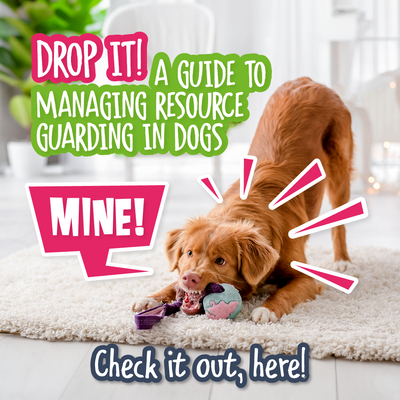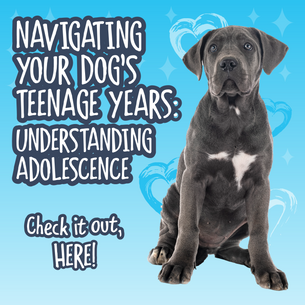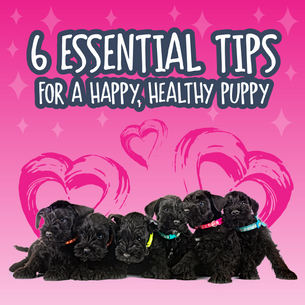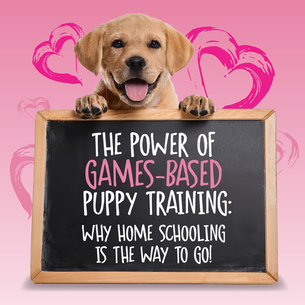“Drop It!” “Argh, let go!”
Familiar?
Whether it’s stolen socks, a warm spot on the sofa or a favourite chew - or something seemingly more random like a piece of rubbish - having a dog who struggles to let go of prized possessions can be more than just a nuisance. At its most extreme, it can lead to a bite or result in a trip to the vet when something inappropriate has been swallowed, so understanding and managing this behaviour is crucial.
In this blog, we dive into the fascinating world of Resource Guarding, unravelling what’s happening inside your dog’s brain when they refuse to “drop it!”. We’ll walk you through why some dogs hold onto objects with such intensity and offer practical, actionable strategies to tackle this challenging behaviour and help your dog feel more relaxed around resources - and more able to let go!
What is Resource Guarding?
It can help to think of Resource Guarding as any change in behaviour your dog displays in the presence of a resource, when a person or another dog approaches. This could manifest as growling, snapping, swallowing, or even stillness. Crucially, this change of behaviour is driven by a negative emotion your dog is experiencing at that moment.
Resource Guarding is commonly misunderstood, and, as consequently often results in labels - especially if we view it through the lens of human emotions. Maybe your dog growls when your partner sits next to you on the sofa, or reacts when you give attention to another dog.
In those situations, it can be easy to jump to the conclusion that your dog is jealous. This same thinking often applies to dogs guarding toys or food from other dogs.
In truth, Resource Guarding, like all behaviour struggles, is motivated by a lack of key skills, or concepts. Understanding this is crucial to transforming it. It's not that your dog truly wants to own the shoe, cardboard, or spot on the couch.
To assume it’s about jealousy or simple attachment to the item is to miss the real cause and the chance to resolve the issue effectively.
So, what's actually going on?
Breaking Down the Basics: Why Do Dogs Guard Resources?
There are a number of factors that typically play a part in any Resource Guarding struggle. Not every Resource Guarding struggle will involve all these factors, although it is possible to see elements of all at play, so understanding them is vital. Let’s briefly consider them one by one.
Factor 1: Disengagement Struggles
As a concept, disengagement - or an inability to see value in moving away from something - is often at the heart of a struggle with Resource Guarding.
For dogs who lack this skill, Resource Guarding will typically happen when they find themselves in a situation where they have a “thing” - whether that’s food, a toy or even a warm sun puddle on the floor - and then a person or another dog tries to intervene and make them leave that “thing”.
Because that crucial “disengagement” building block in their brain is missing, they feel mounting pressure and conflict. Unless that pressure cooker situation is diffused, the result is often an escalation in behaviour - those outward signs of the inner conflict your dog is feeling - which can range from growling, snarling and biting, to swallowing the item.
Helpful questions to ask yourself when you think a struggle with disengagement might be contributing:
- Does your dog struggle to remove their attention from other things and in other situations (e.g. squirrels, toys, bikes, cars, people, other dogs, sights and sounds outside the window)?
Factor 2: Movement is Important
Dogs who Resource Guard have often learned that movement - whether from humans or other dogs - is important.
Perhaps, as a puppy, your dog got into the habit of stealing objects, leading to a chase and a tussle to get the item back. As a result, they have learned that your movement - particularly movement towards them - means losing their “prize”.
Dogs can also learn to be wary of the movement of other dogs they live with, especially if they live in a multi-dog household and happen to share their home with an older dog who is less tolerant of their youthful exuberance and who occasionally feels pushed to tell them off.
Dogs who get overly excited by any kind of movement - whether it's a child running, a door opening, or someone simply walking past - often struggle with Resource Guarding too.
Dogs can also learn to be cautious and wary about human movement if their interactions with people are unpredictable. Sometimes those interactions are fun and positive. At other times, perhaps they accidentally leave your dog feeling a little overwhelmed or worried. You might see this if you have young children whose unpredictable movements can startle or worry your dog.
This inconsistency can create a cocktail of emotions for your dog, leading them to feel conflicted and unsure. In turn, when they are already struggling to disengage from an object or situation, human movement can ramp up the negative energy even more, adding fuel to the fire of Resource Guarding behaviour.
In all cases, your dog has learned that movement - human or canine - carries significance, triggering heightened negative emotions which can result in Resource Guarding behaviours.
Dogs who have a challenging relationship with human movement as a contributing factor of their Resource Guarding struggle will often have other behaviour struggles too - with Separation Anxiety being a very common one.
These dogs often become hyper aware of human movement because it signals being left alone - so if your dog struggles in both areas, their relationship with movement is very likely to be playing a part.
Helpful questions to ask yourself when you think a struggle with movement might be contributing:
- Can your dog relax when people are moving around your house, or do they struggle to settle and tend to follow you around?
- Does your dog find movement (e.g. other dogs, cars, bikes, washing machines etc) generally exciting?
Factor 3: Stillness is Important
OK, so this might seem to completely contradict the previous point, but the key here is understanding the relationship between movement (or stillness) and emotional state.
You’ll be familiar with this if you’ve ever done an air sprint to get your energy up, or felt more energised after exercise.
Movement and movement patterns are intrinsically linked to arousal; quick, jerky, erratic movements heighten arousal, while slow, fluid flowing movements lower arousal and are characteristic of calmness. Compare the fluid trotting of a calm, relaxed dog with the explosive, staggered, short sharp movements that characterise a dog who is over-aroused, barking and pulling on lead because they are experiencing fear or excitement.
Dogs that guard resources often choose stillness rather than movement. The challenge here is that the longer your dog remains still, the more the pressure builds. This stillness can become a trigger for conflict as they end up feeling trapped and unable to escape the situation.
Dogs are often much less optimistic or confident when still, making them more prone to negative reactions too. It's also much harder for a dog to disengage in stillness compared to when they’re moving. They literally get stuck.
Helpful questions to ask yourself when you think a struggle with stillness might be contributing:
- Does your dog seem to guard spaces or areas (their bed, the sofa, a favourite spot on the floor)?
- Does your dog struggle with being handled?
- Does your dog have challenging interactions with other dogs?
- Could your dog be stiff or sore?
Factor 4: Your Dog’s Relationship with Objects
Certain objects - like tennis balls or bones - can trigger changes in your dog's energy, focus, and emotional state too.
Your dog might guard an object because it represents something stressful, like a harness associated with stressful walks. Perhaps your dog doesn’t enjoy the handling associated with having their harness put on, because they find it uncomfortable. Maybe they start to hide away when the harness comes out because it has become a predictor of those stressful things that happen on walks. The emotions associated with that harness are negative.
Then one day, you accidentally drop the harness on the floor, and all of a sudden your dog is guarding it, growling when you come near, and giving all the “back off” signals they can muster. It’s not that they want to possess the harness, but simply that they are worried about the experience associated with it, are stuck in stillness, and are struggling to disengage.
Or think back to that puppy who became a master at stealing socks. Having objects quickly snatched from their mouth can change that puppy’s relationship with socks. The object was really fun, and suddenly it’s forbidden. That’s one serious conflict of emotion that’s been created!
Helpful questions to ask yourself when you think a struggle with objects might be contributing:
- Does your dog tend to resource guard particular objects?
- Does your dog’s energy and focus change when those objects are present?
- Is there any negative history with those objects (e.g. items being taken away in the past, worry or fear when the object has been presented in the past, high energy games played with that object)?
Factor 5: The Stress Bucket
Your dog's "stress bucket" - that emotional threshold every dog has - can be a key factor in Resource Guarding too.
It might be the case that your dog is particularly prone to Resource Guarding when their bucket is full, but when it's emptied or managed well, the guarding often disappears.
This fluctuating behaviour is a clue that Resource Guarding may be linked to how full their bucket is.
Your dog might guard more during stressful times, like holidays, or after a health issue, but the behaviour fades as the stress lessens.
Keeping your dog’s stress bucket empty as a matter of course is vital for every aspect of their life - and could well be the key to helping resolve, or manage, their Resource Guarding struggles too.
Helpful questions to ask yourself when you think a full stress bucket might be contributing:
- How quickly does your dog react to things around them (barking, whining, pacing, growling, guarding, etc.)?
- What events (exciting or scary) could be filling your dog’s bucket?
- How quickly does your dog go back to “normal” after reacting to something exciting or scary?
Crafting a Plan: Focus on the Key Contributing Factors
To address Resource Guarding effectively, you need to focus on the main contributing factors.
In any Resource Guarding struggle, there will be some factors that contribute more strongly than others.
This won’t be the same for every dog, so identifying, and tackling those key contributors will get far better results, and create far less overwhelm, than trying to tackle everything at once.
Movement is Important
Suppose you realise your dog currently attributes far too much importance to movement. Start by making subtle changes, like limiting how much your dog is exposed to human movement or ensuring that interactions with family members are predictable and positive.
Play games like DMT (Distraction, Mark, Treat) to change your dog’s emotional response to human movement and give them plenty of opportunities to practise calmness.
Over time, you'll help your dog manage their emotions better, reducing the likelihood of Resource Guarding taking hold.
Find this super game and so many more in the free Absolute Dogs Optimism Rocks eBook.
Stillness is Important
Maybe your dog struggles with stillness. You might have observed this in other contexts too. Dogs who get “sticky” often freeze part way through an interaction with another dog, turning a calm, polite greeting into one of friction and escalating reactivity.
Practice games to help your dog move from stillness to movement calmly and to grow your dog’s Dimmer Switch, working towards small improvements to reduce struggles and increase emotional balance.
A Full Stress Bucket
If you know your dog often struggles with a full stress bucket, it’s essential to consider what is routinely paying into that bucket and address their overall stress levels.
Think about your dog’s overall lifestyle and consider what might be filling that bucket. Remember that positive events can fill your dog’s bucket as well as negative scary ones.
Consider supporting your dog with a natural calming supplement such as A-OK9’s Calm-K9 for optimal brain, gut and behaviour.
Check out the free Absolute Dogs Calm eBook for some super strategies you can start implementing right away.
Observe your dog. Become their expert! Then make tweaks to your dog’s lifestyle, and play games, like those you’ll find in Games Club - the home of games-based concept training - to skill your dog up in those areas.
The Art of Disengagement: Do A Hair Toss and Check Your Nails!
If in doubt about where to put your focus, grow the skill of disengagement!
In the context of Resource Guarding, your goal is to teach your dog that moving AWAY from things is rewarding - and you can do this by playing games.
As with any behaviour struggle, in order to reshape your dog’s brain you need to be training FOR the situation rather than working in the situation. Don’t be tempted to play games or train with any resource your dog has a history of guarding.
Here’s a simple game to get you started. Work through the levels at your dog’s pace, always setting them up for success.
Disengagement Game
This game teaches your dog that there is more value in coming away from something (disengaging) than in engaging with it.
Level 1: Neutral Location, Neutral Object
Play the game with a variety of neutral objects (things your dog has no history of Resource Guarding) in a neutral location (somewhere your dog has no history of Resource Guarding).
Place one piece of food towards the object for your dog to go and get. When they choose to orient back towards you, give them several pieces of reinforcement (feed, feed, feed!) as you move away from the object, showing them they made a really great choice to disengage.
Level 2: Charged Location, Neutral Object
Play the game with a variety of neutral objects (things your dog has no history of Resource Guarding) in a charged location (somewhere your dog has a history of Resource Guarding).
Level 3: Neutral Location, Charged Object
Play the game in a neutral location with an object you have attributed some importance to (NOT an object your dog has a history of guarding).
Depending on your individual dog and their particular Resource Guarding history you might have a fun game of tug with a toy before placing it out as your charged object and asking them to disengage from it.
If you’re working with a dog who has a history of Resource Guarding toys, a neutral object like a cone or a plant pot can be charged (have some significance attached to it) by making it part of a game first.
Level 4: Charged Location, Charged Object
Finally, play the game in a location where your dog has a history of Resource Guarding, with your newly charged object to combine the learning steps - working up to using an item your dog has previously guarded.
Rehearsal and Lifestyle
If you’ve read our blogs before, you’ll know that we regularly talk about the importance of rehearsal. Rehearsal is powerful!
The more a dog practices guarding behaviour, the more entrenched it becomes.
If your dog has repeatedly guarded a resource and had that behaviour reinforced (even unintentionally), it’s likely to spread to other contexts and escalate over time.
Identifying and addressing the key contributing factors in your dog’s Resource Guarding struggle is just one piece of the puzzle. It’s also important to recognise that those factors will be contributing for a reason.
If your dog is missing that key skill of disengagement, there will be a reason! If your dog finds human movement really exciting, there will be a reason! And that reason is likely to be rooted in what they are rehearsing in day to day life, and the situations they are finding themselves in.
How is their lifestyle contributing to the picture? And what changes might it be necessary to implement to minimise that rehearsal?
At the very foundation of transforming a struggle with Resource Guarding is making sure you have management strategies in place to avoid any situation where your dog feels that conflict which leads to them guarding.
Rehearsal is powerful and is something you want to avoid at all costs – both for the safety of everyone in your household and because the emotions your dog experiences when they are displaying this behaviour are not ones you want them to feel.
Here are some ideas.
Gates, pens and crates
Using gates, pens and separate rooms of your house to give your dog plenty of time away from the movement and busyness of your household can really make a huge difference.
This will be particularly important if your dog exhibits Resource Guarding around food. Allowing your dog to eat in peace away from other family members (human and canine) will minimise the chance of any rehearsal. Making sure your dog has time away from any other dogs in your home, especially when there are any valuable resources present, will be vital too.
This will also give your dog’s stress bucket time to empty.
Ditch the Bowl and Ditch the Routine
Anything that is predictable can increase the likelihood of Resource Guarding happening because of the power of predictors for your dog.
Check out these free resources for some Ditch the Bowl and Ditch the Routine inspiration:
It will also be worth considering whether food is too much of an ‘event’ and whether the way your dog gets their dinner could have contributed to your struggle.
You might have been encouraged to put food in a bowl and ask your dog to “Wait, wait….” before releasing them to eat. While this might be considered a great way of teaching manners and impulse control around food, it actually adds a significant amount of arousal and teaches your dog that food in the presence of a person is a significant event.
This is another great reason for ditching the bowl!
Simplify your dog’s environment
Set your dog up for success while you’re growing their skills by making the environment less complex. Remove any item your dog has any history of guarding, as well as any objects which could present a challenge.
Over time, gradually add neutral objects back into the environment (items which have no prior history of Resource Guarding), and then encourage calmness around those new objects.
Let It Go! Let It Go!
Addressing Resource Guarding requires a deep understanding of the underlying concepts and a well-crafted plan.
By focusing on disengagement, boosting your dog’s skills and managing their lifestyle you can help transform their behaviour and improve their relationship with resources.
Remember, successful intervention involves not only understanding the behaviour but also implementing effective strategies and management techniques.
Resource Guarding struggles aren’t always straightforward, and often they require additional guidance and support. If you’re struggling to make progress with your dog’s Resource Guarding, one of our Pro Dog Trainer Connect consultations could be exactly what you need. These are a chance to receive tailored, personalised dog training guidance from one of our Pro Dog Trainer experts, with coaching that targets your specific struggles and an actionable, expert-crafted training plan.
With the right approach, you can help your dog overcome Resource Guarding and lead a more harmonious life where they really do love to let it go!




